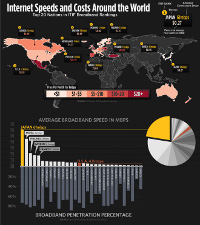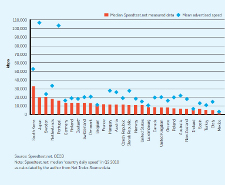Reflections on Mexico's bandwidth
Around two years ago, the OECD presented a study on residential bandwitdth available per country that triggered quite a bit of debate all over the world — I have seen at least criticism to it in Mexico, in the USA and in Australia. It’s very easy to take a simplified view of a statistic and bitch on how sorry the state of our country is. In our case, the outcry was that Mexico was the lowest of all of the OECD countries, and I have seen this repeated on so many topics that it what surprises me is that people keep getting surprised at it! OECD does not represent the ≥200 countries in this world (only the top 30, and the meaning of “top” is not unambiguous).
I found this graph that helps me illustrate this point:
While that graphic is part of a report illustrating how sorry the USA should be for their low position, it shows the OECD member countries. And yes, the only country Mexico could be compared in general terms from those in the list is Turkey. Coherently, they are located at positions 28 and 30.
But what prompted me into writing this post? That some weeks ago I was reading a viewpoint article at the Communications of the ACM magazine: What gets measured gets done: Stop focusing on irrelevant broadband metrics, by Scott Wallsten (might be behind a paywall for you — If you are interested, I can share a copy with you, just ask me by email). Wallsten’s article contains the following graph:
I found it pretty telling that, although Mexico sits at the extreme of the graph (and the height of our bar makes it very hard to get a real value out of this particular rendering), our ISPs join a very select group of countries (Sweden, Germany, Belgium, Luxembourg and Ireland, in my very subjective measure) by delivering what they promise.
In 2010, the dominant broadband offering was 1Mbps, although higher options have long existed. I always got basically the 100% of what my ISP (Telmex) has promised, even though I have always had the cheapest package available. Some months ago, I got a call announcing we were being pushed 5x into the future, and starting right then, I had a 5Mbps connection. And although I didn’t really expect it to be true, I have had a clean 6Mbps (yes, 6 instead of 5) connection.
So, that’s it. This post contains no hidden truths, but just what grabbed my attention from a series of data points :-)
Attachments
Measured and advertised download speeds (in kbps) (253 KB)
Measured and advertised download speeds (in kbps) (40 KB)
Residential Internet speed comparison per country (2010) (397 KB)
Residential Internet speed comparison per country (2010) (24 KB)
Comments
Anonymous 2012-03-10 05:18:03
there is something to point
there is something to point out I think, and is the cost represented for each country. means a lot, about economy, politics, and more, about each country. I am from Argentina, the cost is high and the quality really poor. People are prisoners of communication enterprises. Although great porcentage of people have access to the internet, the cost is restrictive for the entire population. Looks like what happens in Mexico, I dont know, but maybe the distance from the northern hemisphere make things worse here.
gwolf 2012-03-12 10:31:44
Copyrighted and protected article - I cannot just post it here
However, the ACM will not get angry if I share it privately – You will find it in your mail ☺
gwolf 2012-03-21 07:30:41
I’d love to know
But as I said, I’m only reproducing the graphs… You should check with the authors :-/
gwolf 2012-03-21 07:33:51
Compare with the comparable
I’ll be happy to mail you the article - Just mail me privately (gwolf at gwolf.org).
As for your last paragraph: Do you really think that US$30 for phone+Internet service is “expensive compared to most countries”? I don’t. And even more: Even if it were, try comparing with our league: With other Latin American countries. You will find that Mexico is among the richest - And Internet service is among the cheapest.
Again, we cannot compare with countries so far away from our reality as Japan or Finland. Right, we should also not compare with i.e. Paraguay (the poorest country in South America). But we can compare with countries similar to ours, such as Argentina, Perú or Colombia.
gwolf 2012-03-21 16:30:14
Reality check on the numbers
US$30 in Mexico gets you not 0.5 but 5Mbps. Which is still less than what you’d get for that money in the USA, but not anymore by much. But, again, it’s obvious: Comparing the prices we get for telecommunications with the USA’s prices will never look good. We must compare against economies on pair to ours.
I will not make a full research for this, but:
- CNN Expansion, 2010: Mexico the cheapest per megabyte, Uruguay the most expensive (sample: Argentina, Brazil, Chile, Colombia, Ecuador, Perú, Uruguay and Venezuela).
- Speedy (Argentina): AR$109 (~US$35) per month, 3.5Mbps
- Claro (Perú): S/80 (US$35) for 1MBps (many other packages shown)
- Telefónica Colombia: Starts at US$46 monthly for 1MBps, US$58 for 4MBps, US$88 for 6MBps
RoboTux 2012-03-10 03:07:12
Hi, thanks for your post. I
Hi, thanks for your post. I just have a small question: why France does not have a mean advertised speed in the second graph?
shirish 2012-03-12 08:55:00
Looking forward to the article.
I am looking forward to you sharing the article.
vichaox 2012-03-15 13:07:10
I’d also like a copy of that article.
It’d be really nice if they shared how are they getting those measures since a vast majority of testing sites and apps are, IMO, importantly affected by TCP Windowing and stuff like that.
It is also worth to note that Telmex has not only increased bandwidth throughout the City but upgraded the network as well, so as soon as they switch the Central Office close to you to fiber optics you will be upgraded to a 12Mbps at no cost.
The real thing affecting bandwidth in Mexico is economy, no matter if you have the money to pay for it, it is expensive compared to most countries. But that’s a whole other story.
Thanks for sharing.
vichaox 2012-03-21 11:05:00
Purchasing Power
I might not have expressed myself correctly. Let me try to elaborate further:
US$30-$45 is the amount of money that Verizon (to cite some random example) charges customers for the same DSL service in the US (of course getting the US$45 bundle gets you 15Mbps while getting the US$30 gets you .5Mbps).
The purchasing power of US’ inhabitants is, to put a number, 10 times greater that of Mexico’s inhabitants.
The price of the service in Mexico is not bad at all, it matches the global tendency. But as I said the problem is Economy, the money we spend on internet access is a much more considerable piece of our monthly income than to those other countries’ inhabitants. My thoughts are about the Economy, not about the service or the price of such service.
vicm3 2012-03-09 19:18:24
Well but how many are using it?
Inegi [1] has data about how many had lines, uses “Internet” and other nice data, but on bandwith there is no raw data, and one important thing speednet only has nodes to make test in México only very recent like 2 years ago.. before the near test where in LA.
Personally I would like a map like the one on connectivity but for México… anyway last month there was a interesting to say the least proposal in Zacatecas [2] to make Internet access a constitutional right…
[1] http://www.inegi.org.mx/Sistemas/temasV2/Default.aspx?s=est&c=19007 [2] http://zacatecasonline.com.mx/noticias/local/19973-acceso-internet-derecho.html

